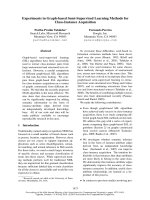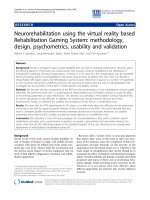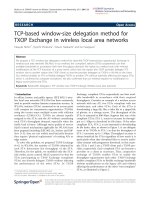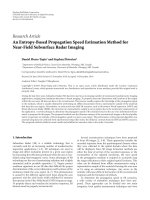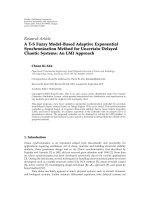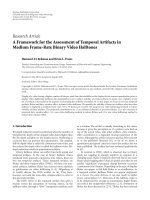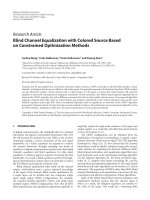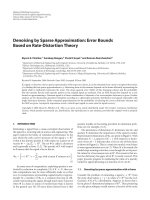Object level frustum culling based frame rate acceleration method
Bạn đang xem bản rút gọn của tài liệu. Xem và tải ngay bản đầy đủ của tài liệu tại đây (568.69 KB, 13 trang )
Computer science and Control engineering
Object level frustum culling based frame rate acceleration method
Le Hoang Minh1*, Tran Binh Minh1, Luu Van Sang1, Hoang The Khanh2
1
Military Information Technology Institute, Academy of Military Science and Technology;
Missile Institute, Academy of Military Science and Technology.
*
Corresponding author:
Received 16 Sep 2022; Revised 5 Dec 2022; Accepted 15 Dec 2022; Published 30 Dec 2022.
DOI: />2
ABSTRACT
Frame rate is an important index to evaluate the performance of simulation systems. The higher
it is, the more intuitive and realistic the simulation application will be. The terrain database
rendering process in the simulation field takes a lot of time and hardware resources. Therefore,
optimizing it leads to a significant speedup of the simulation system. The frustum culling method is
very helpful in avoiding computations of things that are not visible. In this method, instead of
sending all information to the graphics processing unit, visible and invisible elements will be
sorted, and only visible elements will be rendered. This paper presents an effective frustum culling
technique at object level. In the proposed method, the rendered region was frustum culled by
objects, so the number of objects to be rendered in each frame was significantly reduced. The
purpose of the study is to improve the rendering performance of terrain data in the Unity 3D
framework. Experimental results have shown that the given method is very competitive.
Keywords: Frame rate; Culling; Simulation; Terrain database; Image render; Unity 3D.
1. INTRODUCTION
1.1. Frame rate in the simulation field
In the simulation field, frame rate (FR) indicates the number of frames the screen
displays per second or the refresh rate of the screen. FR is measured by frames per
second (FPS) unit and is one of the most important factors that affect to user's
experience. In fact, the higher FR is, the smoother the displayed image will be, and the
more realistic the user will feel. And vice versa, low FR (with FPS <20) will cause jerky
lag, adversely affecting the user experience, and in many cases can cause dizziness and
nausea [1].
Normally, FR is divided into the following segments:
- 24 FPS: the FR commonly used in filmmaking is the minimum speed that allows
users to feel the movements realistically.
- 30 FPS: this is a common FR, considered the minimum standard on games and
simulation to ensure the majority of users won't notice any lag.
- 60 FPS: often considered the ideal FR, the balance between user experience and
investment costs for system configuration.
- 120 FPS: this speed can only be achieved on computers with powerful hardware
connected to a monitor with a refresh rate of up to 144Hz and a well-optimized program.
The ideal FR value in simulation systems is 60 FPS, but it is difficult to achieve in
practice, so any value in the range from 30 FPS and 60 FPS is acceptable.
1.2. Factors affecting frame rate in simulation applications
To understand which factors affect FR in simulation applications, first, we should
28 L. H. Minh, …, H. T. Khanh, “Object level frustum culling based frame rate acceleration method.”
Research
know the frame life cycle, where it begins, and what course it takes. Actually, the life
cycle of the frame is quite complicated, but in this study, we give a brief description with
the main purpose of analyzing the factors affecting the FR. The life cycle of the frame is
illustrated in figure 1. In this cycle, at first, the simulation application sends a frame to
the Central Processing Unit (CPU), then the CPU calculates and processes the frame and,
after that, sends it to the rendering queue of the Graphics Processing Unit (GPU). In the
next step, the GPU performs calculations (geometry, texture, shading…), puts them into
the render buffer and finally outputs to the monitor to display. In the same way, all the
next frames are processed and displayed by the monitor.
Figure 1. Life cycle of the frame.
There are some main factors that affect FR in simulation applications [2]:
(1) Hardware and its quality (CPU, RAM, GPU and monitor)
The device facilities and their qualities greatly affect the FR. A device with a faster
CPU, a higher capacity RAM and a higher GPU will perform faster processing and
consequently higher FR and vice versa. In addition, a monitor with a low refresh rate
might not display all the frames it receives from the GPU in simulation systems with a
high FR.
(2) Code and calculation optimization
This factor is greatly related to developers of simulation systems which deal with FR.
The code writing style affects the FR directly as the more well written the code is and the
smarter the calculations are, the higher the FR can get and consequently can avoid
choppy movement.
(3) Content of the frame
The content of the frame affects the FR as the frames with high resolution take
relatively much more time for rendering than those with low resolution. In simulation
developing, each object has its own scripts, codes and calculations. So, the more objects
present in the frame, the more calculations there would be and the more time needed for
rendering that frame and consequently this would affect the FR.
(4) Applications running in the background
There may be programs and services running in the background, and these
applications will take possession of the device resources and indirectly affect the FR of
other applications.
1.3. Common methods to enhance frame rate
Based on the factors that affect FR mentioned above, there are some common
methods to enhance FR in simulation applications as follows:
Journal of Military Science and Technology, Special issue No.6, 12- 2022
29
Computer science and Control engineering
(1) Upgrade hardware
One of the simplest ways to improve the FR is choosing high configuration devices to
implement simulation systems with high FR. However, this depends on the user's ability
to invest and is not always possible, especially in the case of reusing of available
equipment.
(2) Optimize software and database rendering
Optimization in designing, building database and coding would reduce the number of
computations and increases the FR. Normally, simulation frameworks or third-party
applications provide tools for optimizing the code of simulation applications but the
combination with developer’s knowledge will be better.
(3) Culling content of the frame
As mentioned above, the more objects present in the frame, the more calculations
would be and the lower FR is. Therefore, in simulation systems, decreasing the number
of objects in the frame would make FR becomes higher.
(4) Restrict background applications
Turn off the programs and services running in the background when don’t need to
save as much of the device resources as possible. However, this can only be done by
users of simulation systems, not developers.
In this study, we concentrate on the third method (culling content of the frame) by
reducing the number of objects in the frame. The rest of this paper is organized as
follows: problem and methodology are described in section 2 and section 3 respectively.
Section 4 presents experiments, results and discussion. Finally, the conclusions are given
in section 5.
2. PROBLEM
2.1. Frame rendering process in Unity 3D
Unity 3D [3] is an advanced framework to build simulation systems, especially in
virtual reality (VR) and augmented reality (AR) fields. Due to the high computation cost
of rendering real-time animation, performance optimization plays an important role in
Unity 3D software development [4]. The main rendering process in Unity 3D is similar
to that described in figure 1, for each frame, the specific process at object level is
presented in Figure 2 as follows [5]:
(1) CPU
- Step C1. Create frame object list:
Analyze the scene to be rendered and make a list of all objects in the frame (list L1)
without paying attention to objects that are obscured or out of view.
- Step C2. Culling:
Divide the scene into bounding boxes with dimensions determined by Unity 3D. If a
bounding box is outside the field of view (FOV), all its objects will be removed from the
list L1. If a bounding box is inside or intersects with the FOV, all its objects will be kept
in the list L1. In addition, objects also will be removed from list L1 if they are not in the
layer the camera chooses to display or be obscured by other objects. The result of this
30 L. H. Minh, …, H. T. Khanh, “Object level frustum culling based frame rate acceleration method.”
Research
step is list L2 (called culling data).
Frame rendering in Unity 3D
CPU
GPU
Monitor
Start
C1. Create frame
object list
C2. Culling
C3. Collect objects
data
New objects data
(new objects, status
change objects)
C4. Compare data
G1. Store new object data
into memory
Confirm receipt of
data
C5. Create opaque,
transparent object list
Opaque list,
transparent object list,
resource request
C6. Render setup
Confirm receipt of
data
G2. Store opaque,
transparent object list into
memory and set up
resources
C7. Draw
Draw complete
Opaque list
empty?
No
G3. Render the first object
in opaque/transparent
object list to frame buffer
Yes
G4. Send frame image to
monitor
Display frame image
Stop
Figure 2. Frame rendering process in Unity 3D.
- Step C3. Collect objects data:
All information of selected objects in L2 such as mesh (skeleton structure), material
including textures, shaders, position, color, mapping,... is collected and stored by the
CPU.
- Step C4. Compare data:
Collected object data will be compared with the corresponding data of the previous
frame (in case the current frame is not the first frame). If there is a change to the data (for
example, a new object is added or the state of the object changes), the changing part of
data will be send to the GPU.
Journal of Military Science and Technology, Special issue No.6, 12- 2022
31
Computer science and Control engineering
- Step C5. Create opaque, transparent object list:
All objects in L2 will be divided into opaque object list (L3) and transparent object
list (L4) based on material, light, distance, etc. Opaque object can obscure objects behind
it in the direction of observation and vice versa transparent object can let light through so
objects behind it in the direction of observation can be observed. In this step, in addition,
information about GPU resources to use for rendering will be calculated. For opaque
objects, the closer to the viewpoint will be put in the top of the list and and vice versa for
transparent object.
- Step C6. Render setup:
The rendered objects will be determined, the index of objects in list L3, L4 and
information about GPU usage sent to the GPU.
- Step C7. Draw:
With opaque object list (L3) (organized by stack), the CPU sends additional
information on the first object in the list and a draw command to the GPU, removes that
object from the list. This process will be repeated when the CPU receives the message
that the GPU has finished rendering the object and continues until there are no more
objects in the list.
For the transparent object list (L4), the execution is similar to the L3 and starts at the
time when L3 has been processed completely.
When all the objects in the two lists have been rendered, the CPU sends a finish signal
to the GPU to notify that it is ready to move on to the next frame.
(2) GPU
- Step G1. Store new object data into memory:
Receive new object data from the CPU (step C4), store in GPU’s memory and notify
the CPU that data has been received.
- Step G2. Store opaque, transparent object list into memory and set up resources:
Receive index of objects in opaque object list, transparent object list and GPU
resources information from the CPU (step C5), store in GPU’s memory and notify the
CPU that data has received. Based on received information, GPU does some setup such
as preparing memory, buffer,…
- Step G3. Render the first object in opaque/transparent object list to frame buffer:
Render object specified by the CPU to frame buffer.
- Step G4. Send frame image to monitor:
After receiving the finish signal from the CPU, GPU send frame image in frame
buffer to the monitor to display.
2.2. Analysis
In the frame rendering process of Unity 3D, both the CPU and the GPU must
complete all tasks to render the frame. Therefore, if a task takes a long time to complete,
it will cause a delay in rendering the frame, thereby reducing the FR of the application.
Look detail at the frame rendering process in Unity 3D, we can see that one of the
most effective optimizations is culling at step C2 because the smaller the number of
32 L. H. Minh, …, H. T. Khanh, “Object level frustum culling based frame rate acceleration method.”
Research
rendered objects, the less CPU and GPU resources are used and the higher FR can get.
Three are three types of visibility culling methods frustum, occlusion, and backface, respectively [6] as depicted in Figure 3:
- Frustum culling method (sometimes called view - frustum culling) is used to avoid
rendering object that is outside the viewing frustum (VF);
- Occlusion culling method aim at avoiding rendering primitives that are occluded by
some other part of the scene;
- Back-face culling method avoid rendering geometry that faces away from the
viewer rendering geometry that is outside the VF.
Figure 3. Types of visibility culling method.
The latest version of Unity 3D provides tools for all three above culling methods,
however, this study focus on the frustum culling method, so we will analyze Unity 3D
frustum culling in detail. The main idea of the frustum culling in Unity 3D [7] is
illustrated in figure 4. Although the scene space in Unity 3D is three-dimensions (3D)
but to make the idea easy to understand, we describe in two-dimensions (2D):
- Divide the scene into bounding boxes with dimensions determined by Unity 3D: in
the illustration, we suppose that the grid is divided into 20 bounding boxes (4 rows and 5
columns) numbered by row and column;
- With each bounding box:
+ If a bounding box is outside the VF: all its objects will be removed from the render
objects list (culling data). As shown in figure 4, those boxes are 1.1, 1.5 (out of view
angle), 4.1 4.2, 4.3, 4.4, 4.5 (out of view distance) and all of their objects (denoted as
dashed outline circles) will be removed from the render objects list.
+ If a bounding box is inside the VF: all its objects will be kept in the culling data. As
shown in figure 4, those boxes are 2.3, 3.2, 3.3, 3.4 and all of their objects (denoted as
filled circles) will be kept in the render objects list.
+ If a bounding box intersects with the VF: all its objects will be kept in the culling
data. As shown in figure 4, those boxes are 1.2, 1.3, 1.4, 2.1, 2.2, 2.4, 2.5, 3.1, 3.5 and all
of their objects (denoted as solid outline circles) will be kept.
Journal of Military Science and Technology, Special issue No.6, 12- 2022
33
Computer science and Control engineering
Objects inside viewing frustum
Objects outside viewing
frustum but containing
bounding box intersects with
viewing frustum
Objects outside viewing
frustum and bounding box
does not intersect with
viewing frustum
4.1
4.2
4.3
4.4
4.5
3.1
3.2
3.3
3.4
3.5
2.1
2.2
2.3
2.4
2.5
1.1
1.2
1.3
1.4
1.5
1
Viewpoint (camera position)
Figure 4. Frustum culling in Unity 3D.
As can be seen, the original frustum culling method in Unity 3D takes not only
objects inside the VF but also outside (in case of bounding box intersects with the VF).
As illustrated in figure 4, only objects denoted as filled circles inside the VF, objects
denoted as solid outline circle outside the VF but still taken. This leads to object
redundancy, therefore, the FR will be lower and need higher CPU and GPU resources to
render. The reason is frustum culling in Unity 3D performed at bounding box level (grid
level) and not the object level.
2.3. Related works to solve the problem
To handle the drawback in the Unity 3D culling process, some research works have
been suggested and some notable studies include:
- H.C. Batagelo and al [8] proposed an occlusion culling algorithm for densely
occluded dynamic scenes based on a regular grid that uses opaque regions of the scene as
virtual occluders. Besides the efficiency of representing visible dynamic objects and
temporal bounding volumes, the benefits of using regular grids are strengthened by novel
methods of view-frustum traversal and occlusion computation based on raster principles.
In addition, the algorithm fuses occluders in object space in order to increase occlusion
size and is output-sensitive. According to the timing tests, the overhead due to the
handling of hidden dynamic objects is very low for most scenes.
- Ziyi Wang and al [9] presented a rendering algorithm for large-scale complex scenes
based on Unity. This algorithm is applied to large-scale factory scene rendering in realtime. The main idea of this study was to combine the frustum culling and occlusion
culling methods. The algorithm can be divided into two stages: preprocessing (or
compiling) and runtime. The preprocessing stage focuses on frustum culling by
generation of a database of occlusion from the scene database, and the data of the scene
database and the occlusion database are organized by the spatial data structure of the
34 L. H. Minh, …, H. T. Khanh, “Object level frustum culling based frame rate acceleration method.”
Research
bounding volume level (the same as in Unity 3D). The runtime stage concentrates on
occlusion culling, a LOD algorithm is used to select the appropriate level of detail for the
visible objects. Experiments showed that the combination method can guarantee the
rendering quality, real-time rendering of large-scale factory scene than a single and have
different degrees of improvement in the efficiency of rendering, and the scene is more
complex, more can reflect the efficiency of the algorithm.
- Rodriguez and al [10] suggested a dynamic culling using octrees with Unity for
virtual reality. An Octree is a tree data structure that divides 3D space into smaller
partitions (nodes) and places objects into the appropriate nodes. This allows fast access
to objects in an area of interest without having to check every object. This study focuses
on occlusion culling of dynamic objects by eliminating unnecessary objects whose view
is obstructed by other objects in the forefront. Although it is different from our research
direction, this research helps us orient our future development.
3. METHODOLOGY
This study proposes a novel method for accelerating FR in Unity 3D. The main idea is
to eliminate all objects outside the VF or FOV of observer. Unlike the origin frustum
culling method in Unity 3D, our method is implemented at the object level and consists
of only two types of objects which are inside object and outside object.
- Inside object: an object is within range of the VF and chosen to put in the rendering
list. Look at Figure 5, the objects in the white color region;
- Outside object: an object is out of range of the VF and eliminated from the rendering
list. See the detail in figure 5, the objects in the gray color region.
Objects inside viewing frustum
-> selected
Objects outside viewing
frustum -> eliminated
4.1
4.2
4.3
4.4
4.5
3.1
3.2
3.3
3.4
3.5
2.1
2.2
2.3
2.4
2.5
1.1
1.2
1.3
1.4
1.5
1
Viewpoint (camera position)
Figure 5. Frustum culling in this research.
With this method, it is possible to avoid redundant objects so which significantly
reduces the number of objects in the rendering list and therefore leads to lower GPU
usage. With CPU usage, the calculation cost at step 2 in frame rendering process will
Journal of Military Science and Technology, Special issue No.6, 12- 2022
35
Computer science and Control engineering
increase because of the need to process each object, however, the cost of calculation at
the following steps will be lower because of the number of objects will be significantly
reduced.
To clarify the difference between the origin Unity 3D frustum culling method and our
method, we have a summarization in table 1.
Table 1. Idea comparing between origin Unity 3D frustum culling and our method.
Origin Unity 3D
Case
Our method
Note
frustum culling
Unity 3D origin
Our method
a) Objects inside the VF Put into rendering list
Put into rendering list Same
b) Objects outside the
VF
- Objects contained in Put into rendering list Eliminate from
Difference
bounding box which
rendering list
intersect with VF
- Objects contained in Eliminate from
Eliminate from
Same
bounding box which rendering list
rendering list
does not intersect with
the VF
The implementation process of proposed method as follows:
(1) Bounding box division
g column
Distance sight
limit (DSL)
Left angle sight
limit (LASL)
6.1
6.2
6.3
6.4
6.5
6.6
6.7
5.1
5.2
5.3
5.4
5.5
5.6
5.7
4.1
4.2
4.3
4.4
4.5
4.6
4.7
3.1
3.2
3.3
3.4
3.5
3.6
3.7
2.1
2.2
2.3
2.4
2.5
2.6
2.7
1.1
1.2
1.3
1.4
1.5
1.6
1.7
Right angle sight
limit (RASL)
1
Viewpoint (camera position)
Figure 6. Illustration for the proposed method implementation.
Divide the scene into bounding boxes (same as in Unity 3D), and suppose that we
have a bounding box grid of M row x N column with K bounding boxes (in figure 6, M =
36 L. H. Minh, …, H. T. Khanh, “Object level frustum culling based frame rate acceleration method.”
Research
6, N = 7 and K = 42). Number bounding boxes from 1 to M by the view direction (from
near to far) and columns from 1 to N by the view angle (from left to right).
(2) Visibility evaluation
Based on the viewpoint, determine which bounding box is inside or intersects with the
VF by distance sight limit (DSL).
- Determine the index of column (denoted g) which align with the viewpoint (column
4 in figure 6).
- Perform iteration by row index from row 1:
+ Calculate the farthest distance from the viewpoint to the bounding boxes in g
column:
+ If the farthest distance is less than DSL: Add all bounding boxes of the current row
to the list of bounding boxes inside the VF (BLi) and move to the next row (rows 1, 2, 3
in figure 6);
+ If the farthest distance is greater than DSL: calculate the nearest distance from the
viewpoint to the current bounding box. If it is less than DSL (row 4 in figure 6) then add
all bounding boxes of the current row (denoted h) to the list of bounding boxes those
intersect with the VF (BLc) and stop the iteration. So, we do not need to consider rows
with an index greater than h (rows 5, 6 in figure 6).
(3) View angle evaluation
Based on the viewpoint, determine which bounding box is inside or intersects with the
VF by the angle sight limit (ASL).
a) Consider columns on the left of g column
- From column g - 1 back to column 1:
From row 1 to row h (the row that intersects with the VF in the previous step):
+ If the left angle sight limit (LASL) intersect with the current bounding box then
move the current bounding box from BLi to BLc and switch to the left bounding box (in
figure 6, they are 1.3 in row 1, 2.2 and 2.3 in row 2, 3.2 and 3.1 in row 3, 4.1 in row 4);
+ If LASL does not intersect with the current bounding box, then delete the current
bounding box and all bounding boxes on the left of the current bounding box from BLi
list (in figure 6, they are 1.1 and 1.6 in row 1, 2.7 in row 2).
b) Consider columns on the right of g column
- From column g + 1 to column N:
From row 1 to row h (the row that intersects with the VF in the previous step):
+ If the right angle sight limit (RASL) intersect with the current bounding box then
move the current bounding box from BLi to BLc and switch to the right bounding box (in
figure 6, they are 1.5 in row 1, 2.5 and 2.6 in row 2, 3.6 and 3.7 in row 1, 4.7 in row 4);
+ If LASL does not intersect with the current bounding box then delete the current
bounding box and all bounding boxes on the right of the current bounding box from BLi
list (in figure 6, they are 1.2 and 1.1 in row 1, 2.1 in row 2).
(4) Objects taking
- Bounding boxes in BLi list: take all objects inside them to the object list to be rendered.
Journal of Military Science and Technology, Special issue No.6, 12- 2022
37
Computer science and Control engineering
- Bounding boxes in BLc list: take only objects inside the VF to the object list to be
rendered.
The calculation of the intersection of line and region, region and region, and objects
in the region using conventional geometric algorithms.
4. EXPERIMENTS, RESULTS AND DISCUSSION
4.1. Experiments
To evaluate the performance, experiments were conducted with the following
conditions:
- Hardware: Computer with an Intel Core i7 7800X CPU, 16GB of RAM and GTX
1080Ti graphic card;
- Unity 3D framework: version 2020 3.32;
- Tools for performance evaluation: Profiler Window, Rendering Statistic and Frame
Debugger.
- Terrain database: one kilometer square with 30,000 tree type objects (random
planted);
- Viewpoint: camera is placed in the middle, 8.9m high, straight angle.
4.2. Results and discussion
In order to illustrate the performance of our proposal, with Unity 3D original method
and the given method, we implemented ten times and recorded the CPU usage, the GPU
usage and the FR value. Results are presented in table 2.
Table 2. Performance evaluation.
Unity 3D original method
Our method
Times
CPU usage
GPU
CPU usage
GPU
FR
FR (FPS)
(ms)
usage (ms)
(ms)
usage (ms)
(FPS)
1
36.0
18.0
27.6
24.8
9.1
40.1
2
35.8
17.9
27.4
24.6
9.0
39.9
3
36.4
18.2
27.9
25.2
9.3
40.4
4
36.6
18.4
28.1
25.4
9.5
40.6
5
35.7
17.8
27.5
24.5
8.9
40.0
6
36.3
18.3
28.0
25.1
9.4
40.5
7
36.0
17.9
27.6
24.8
9.0
40.1
8
35.9
18.0
27.6
24.7
9.1
40.1
9
36.2
18.2
27.9
25.0
9.3
40.4
10
35.9
17.9
27.7
24.7
9.0
40.2
Average
36.1
18.1
27.7
24.9
9.2
40.2
The obtained results showed that, in the case of the experimental terrain database, FR
in Unity 3D original method was 27.7 FPS on average. FR in our method was 40.2 FPS
on average, which is significantly higher than the original method and up to standard.
For visualization, we took a screenshot of the rendering results and described in figure
7. It is clear that in the image (a), objects in cross marked bounding boxes are not
rendered because the bounding boxes do not intersect with the view culling, however,
38 L. H. Minh, …, H. T. Khanh, “Object level frustum culling based frame rate acceleration method.”
Research
objects in bounding boxes numbered from 1 to 6 are still rendered and displayed in
image because the bounding boxes cross the view culling. In our new method, all objects
outside the view culling were eliminated from culling data and therefore did not show on
the image (b).
a) Unity 3D original method
b) Proposed method
Figure 7. Experimental results.
5. CONCLUSIONS
In this paper, we presented an advanced method to accelerate FR to enhance the
performance of terrain database rendering in the Unity 3D framework. Based on the
analysis of weaknesses in the Unity 3D process, we improved the frustum culling by
execution at the object level. The experiments have shown that the method has good
performance and efficiency. The research results have been applied in KC.BM.04 [11],
the KC-KT.04/19 [12], and the ĐTVCN.01.22/CNTT [13]. In the future, we will
combine this method with other occlusion culling and back-face culling techniques to
make the culling process more efficient not only in terrain database rendering (compile
stage) but also runtime stage of simulation applications built in the Unity 3D framework.
REFERENCES
[1]. B. Wang and P.-L. P. Rau, “Effect of vibrotactile feedback on simulator sickness,
performance, and user satisfaction with virtual reality glasses”, In International
Conference on Human-Computer Interaction, Springer, pp. 291-302, (2019).
[2]. />[3]. : Unity Real-Time Development Platform | 3D, 2D VR & AR.
[4]. F. Nusrat, F. Hassan et al, “How Developers Optimize Virtual Reality Applications: A
Study of Optimization Commits in Open Source Unity Projects”, IEEE/ACM 43rd
International Conference on Software Engineering (ICSE), pp. 473-485, (2021).
[5]. />[6]. Cohen-Or, Daniel & Chrysanthou, Yiorgos & Silva, Cláudio, “A Survey of Visibility for
Walkthrough Applications”, Proceedings of SIGGRAPH, (2001).
[7]. />[8]. Batagelo, H. C., & Wu Shin-Ting, “Dynamic scene occlusion culling using a regular
grid”, Proceedings XV Brazilian Symposium on Computer Graphics and Image
Processing, (2002), doi:10.1109/sibgra.2002.1167122.
[9]. Ziyi Wang, Meng Tan, Gang Liu, “Research on Real Time Rendering Algorithm for Large
Scale Complex Scenes based on Unity”, International Journal of Science, Vol.4, No.4,
Journal of Military Science and Technology, Special issue No.6, 12- 2022
39
Computer science and Control engineering
[10].
[11].
[12].
[13].
pp.14-18, (2017).
Rodriguez, “Dynamic occlusion culling using octrees with Unity for virtual reality”, The
University of Texas at San Antonio, (2017).
Binh Do Viet, KC.BM.04, Military Information Technology Institute, (2017).
Khanh Hoang The, KC-KT.04/19, Missle Institute, (2019).
Minh Tran Binh, ĐTVCN.01.22/CNTT, Military Information Technology Institute, (2021).
TÓM TẮT
Phương pháp tăng tỷ lệ khung hình dựa trên lọc hiển thị ở mức đối tượng
Tỷ lệ khung hình là một tham số quan trọng để đánh giá hiệu năng của các ứng
dụng mô phỏng, nếu càng cao thì càng đem lại sự trực quan và chân thực cho các
hệ thống mô phỏng. Trong lĩnh vực mơ phỏng, q trình sinh cảnh dữ liệu địa hình
chiếm nhiều thời gian và tài nguyên phần cứng, do đó, tối ưu hóa q trình này sẽ
làm cho cả hệ thống mô phỏng được tăng tốc đáng kể. Phương pháp lọc hiển thị
theo khung nhìn rất hiệu quả trong việc giảm tính tốn các đối tượng khơng được
hiển thị trong khung hình. Trong phương pháp này, chỉ các đối tượng được hiển
thị và không được hiển thị sẽ được phân loại và chỉ có đói tượng hiển thị mới được
gửi đến cạc đồ họa để kết xuất đồ họa. Bài báo đề xuất một phương pháp lọc hiển
thị khung hình đến mức đối tượng. Trong phương pháp đề xuất, vùng kết xuất đồ
họa được lọc theo đối tượng, do đó, làm giảm đáng kể số lượng đối tượng cần kết
xuất đồ họa trong mỗi khung hình. Mục đích của nghiên cứu là cải thiện hiệu năng
kết xuất đồ họa dữ liệu địa hình trên nền tảng Unity 3D. Các kết quả thực nghiệm
cho thấy, phương pháp đề xuất đạt được kết quả tốt so với khi sử dụng phương
pháp gốc.
Từ khóa: Tỷ lệ khung hình; Chọn lọc; Mơ phỏng; Cơ sở dữ liệu địa hình; Kết xuất đồ họa; Unity 3D.
40 L. H. Minh, …, H. T. Khanh, “Object level frustum culling based frame rate acceleration method.”
